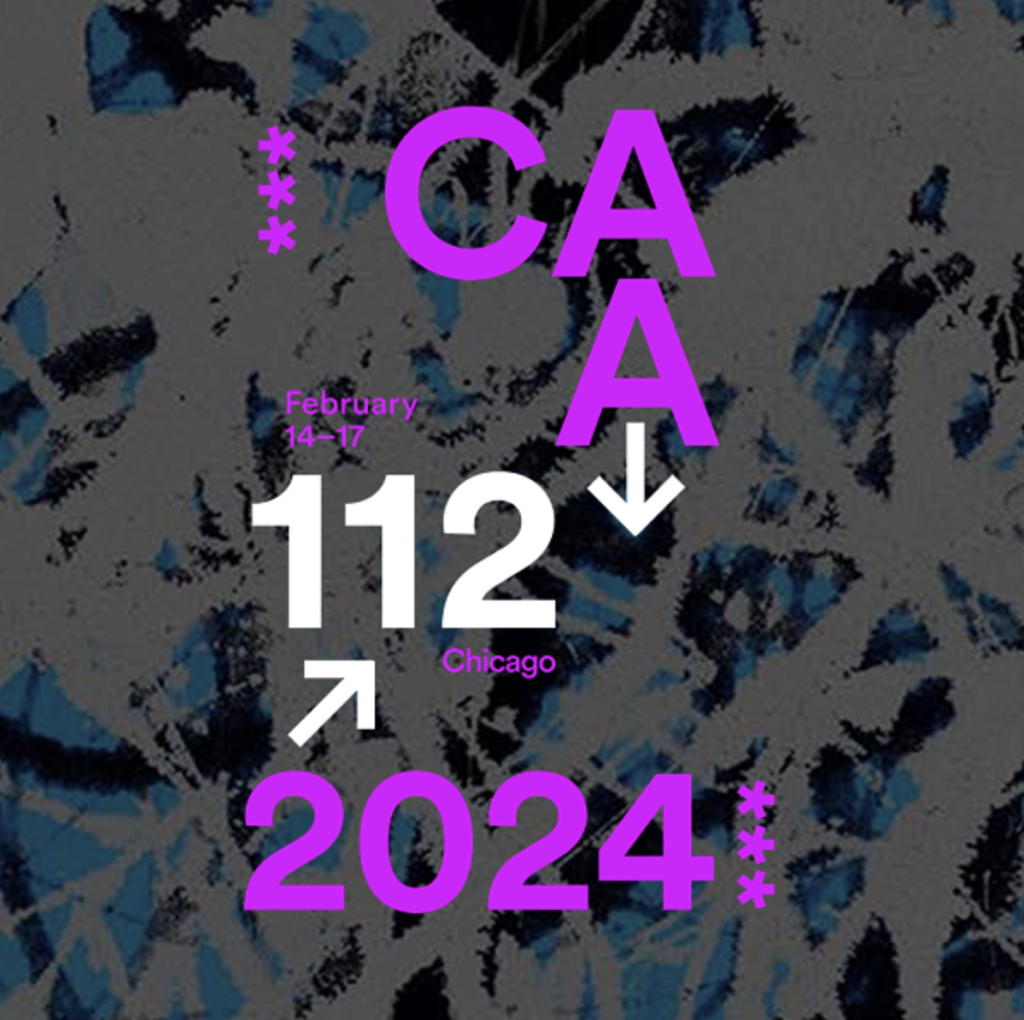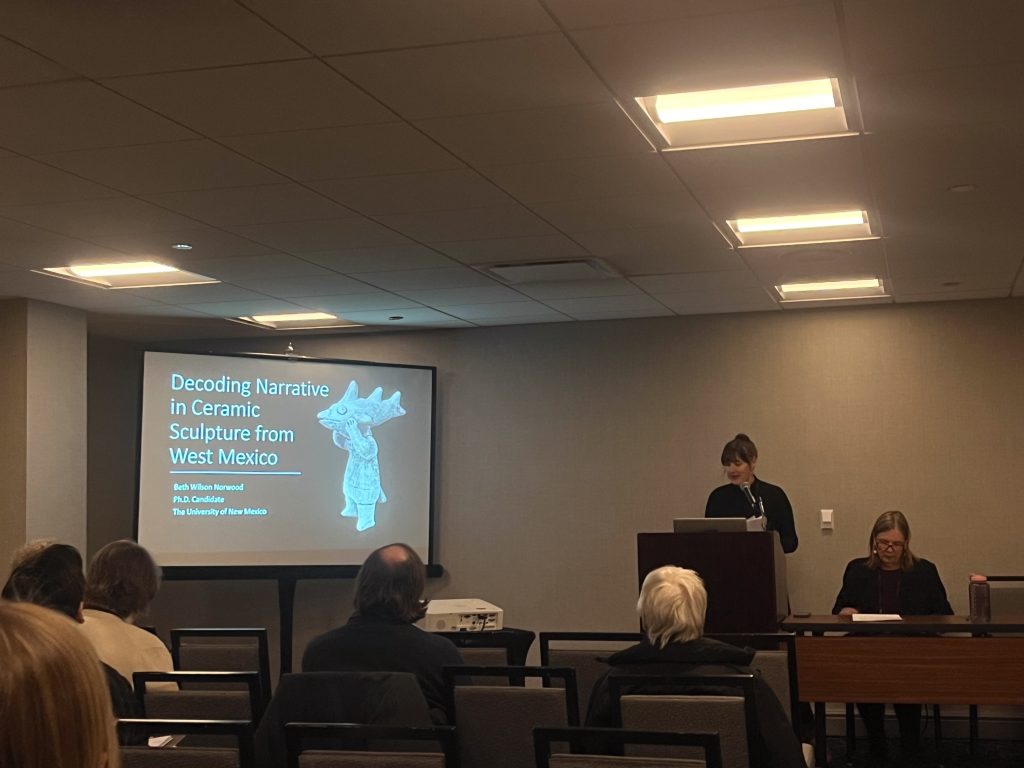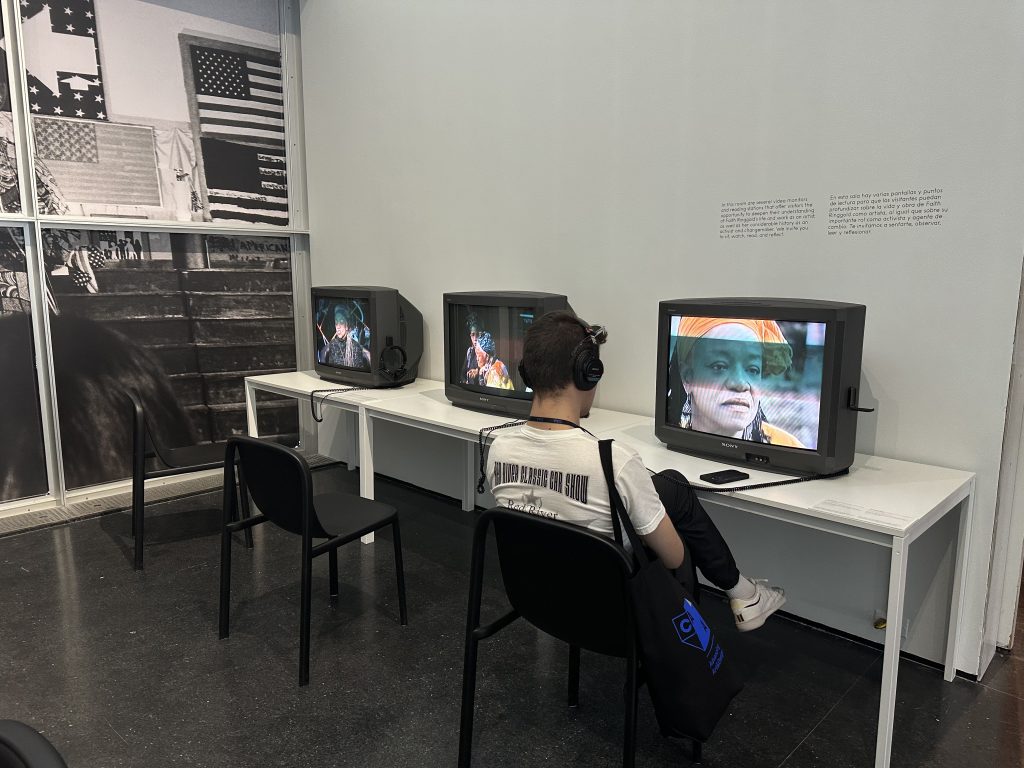Reflections from the 2024 College Art Association Conference

Last month, The University of New Mexico Art Museum funded membership fees, conference admission, flights, and lodging for five student Museum Assistants to attend the 112th Annual College Art Association Conference held February 14-17 in Chicago. CAA is the premier organization for scholars, artists, and educators in the visual arts.
Our Museum Assistants from the UNM Department of Art and Art History presented papers, attended panels, and made connections to further their professional development. Read a selection of reflections from our Museum Assistants below.
This opportunity was possible through a generous award from New Mexico’s Creative Industries Division. We want to continue offering opportunities for professional development to students working at UNMAM, but we need your help! You can invest in the lives and careers of students by donating to the Student Opportunities Fund.

UNMAM Museum Assistant and UNM PhD candidate in Art History, Beth Wilson Norwood, presents her paper at CAA.
Beth Wilson Norwood, PhD candidate in Art History
I attended the 112th Annual College Art Association Conference in Chicago with the help of funding from the UNM Art Museum, the Art Department’s Chair Fund, and the UNM Student Conference Award Program. While at CAA I served as a co-chair alongside Dr. Margaret Jackson and presented a paper. Our session Image and Story: Narrative in the Ancient Americas consisted of four papers on the topic of ancient and colonial art from Mexico and Peru. My paper, “Decoding Narrative in Ancient West Mexico,” presents some of the initial research for my dissertation. Presenting this paper was a valuable experience. Not only did it give me an opportunity to get my research out into the world, it also gave me an opportunity to receive feedback from a community of art historians.
While at CAA I attended a number of sessions related to my field of study, and attended the business meeting for the Association of Latin American Art. In particular, Mary Miller and Megan O’Neil’s sessions on museums and collections of ancient American art were enlightening. Also, at those events I had the opportunity to meet a number of well-respected scholars thus making valuable contacts within my area of study.
When I was not at the conference, I visited the Field Museum and the Art Institute of Chicago. At both museums I spent most of my time in the ancient American sections looking at works from the whole region, and most importantly works from West Mexico. I visited these museums with another grad student specializing in the ancient Americas—Bre Reiss—and our advisor Margaret Jackson. These outings provided an opportunity for the three of us to see objects we study in person and talk about them. These conversations stimulated many ideas and lead to ideas that both Bre and I will include in our dissertations. I’m grateful to the UNM Art Museum for helping me attend CAA.
Hannah Cerne, MA in Art History and Museum Studies
I had the opportunity to attend the 2024 College Art Association Conference virtually. I was able to attend multiple sessions, including Learning from Trees: Artists and Climate Solutions, Imagination and Collage Artist Panel: Shifting Space, Blackness, White Liberalism; and Art, Dress, Music, Material Culture: Female Identity Formation and Agency in Early Modern Europe, and many more. The chance to sit-in on these sessions being presented by artists, art historians, and scholars was beneficial in many ways. I was able to see thought-provoking lectures, thorough research, and unique artworks.
Each session offered a different perspective and focused on the contemporary challenges in our society such as climate change, self-identity, racism, sexism, and other pressing social issues. As I look at my future as a museum professional, I am inspired by the current generation of experts and specialists discussing difficult and demanding topics. I believe museums and institutions have the power to create societal change for the better, and it starts with a conversation. The opportunity to participate as a student at the CAA conference has allowed me to look into my future as a museum professional, and I am eager to begin.

UNMAM Museum Assistant and UNM Art History master’s student, Alejandra Rodriguez (far left), stands will UNM Art History colleagues at the Art Institute of Chicago.
Alejandra Rodriguez, MA in Art History
This trip was one of firsts: my first trip to Chicago, my first CAA conference and my first academic conference at that. I attempted to use every day to its fullest potential; moving from one panel to another, coordinating with fellow students and colleagues to catch the next speaker. Some of the most valuable CAA sessions I attended were chaired by both UNM alumni, faculty, and students.
One of the first panels I attended was presided by a current UNM PhD candidate Mariela Espinoza-León on Sentimental Encuentros: A New Methodology for the Analysis of Mexican Art. Seeing Mariela chair a panel surrounding a methodology (sentimentality or sentimentalismo) that her, her advisor, and colleagues are developing around scholarship of nineteenth century Latin America emphasized the importance of collaboration in academia. Meeting her peers and advisor, and observing their unwavering support for one another was truly gratifying.
My colleague from UNMAM and from the UNM Art History department, Beth Wilson Norwood, co-chaired a panel titled Image and Story: Narrative in the Ancient Americas alongside her advisor and UNM Faculty member, Margaret Jackson. Again, seeing someone I work with has humanized these accomplishments from my colleagues and made them feel more attainable. With hard work and perhaps guidance from my colleagues I can see myself following in their footsteps. During the panel, the presentation “Nahua Women Emerge from the Mist: Reframing the Narrative” by Alanna Radlo-Dzur, intrigued me due to its relevance to my research area. My work on representations of indigenous women in New Spain, while a broad topic, incorporates case studies to reveal women’s experiences in this period. Radlo-Dzur’s presentation highlighted the marginalization of women’s voices in early Spanish documents on Mesoamerican culture, focusing primarily on Nahua women. Radlo-Dzur identified crucial instances of women’s autonomy in the Florentine Codex through her translation of Nahua/Spanish texts and her analysis of imagery, despite the incomplete depictions of women offered in these texts. I had the opportunity to chat and exchange contact information so that I can ask further questions about her work as it pertains to my research. I probably would not have gone to talk to her if it were not for my colleagues that pushed me to overcome my nerves and talk with Radlo-Dzur. This kind of support from familiar academics is invaluable.
After Chicago, I feel a stronger bond with my academic peers, reaffirming what my advisor often emphasizes: these individuals will be the people who I will be surrounded throughout my career. This conference has broadened my horizons regarding potential career paths, while also making professional art spaces feel more interconnected and intimate. Although I met new students and professionals, the most significant relationships tended to be those I already cultivated, and I am fortunate to have had the opportunity to deepen these connections in a new context. I would like to express my gratitude to the UNM Art Museum for funding this enriching and groundbreaking experience for myself and my colleagues.

UNMAM Museum Assistant, Cruz Davis-Martinez, views the exhibition American People at the Museum of Contemporary Art Chicago.
Cruz Davis-Martinez, BA in Art Studio and Psychology
Chicago had been a place that I always dreamed of going to, let alone for its art. Among the mirage of deep-dish pizza and hustle-and-bustle atmosphere lies a nuance to Chicago that I had never experienced before. When I attended the College Art Association Conference, I found it integral to advancing my academic and career goals as an aspiring art therapist. Many of the conference sessions heightened my understanding of contemporary trends, methodologies, and critical discussions in art, providing a comprehensive perspective that is crucial for my role. Specifically, I am focusing on the intersection of queer identity and art in my current research studies, and the conference’s sessions dedicated to this topic aligned perfectly with my focus.
Engaging in critical conversations with scholars in this field not only broadened my knowledge base but also enabled me to build valuable connections for future collaborations and mentorship. In particular, sessions such as the Queer Visual Practices of Southwest Asia, North America, and the Middle East and Surrealism’s Queer Methods allowed me to gather a more comprehensive understanding of past and present queer artists that heightened the notion and understanding of queer identity. The conference’s unique focus on the intersectionality of art and psychology presented an opportunity to gain insights pivotal to integrating therapeutic techniques with visual arts.
Beyond the halls of the conference, I was able to experience an opportunity unlike any other in Chicago’s cultural landscape – visiting both the Museum of Contemporary Art and the Art Institute of Chicago heightened my understanding of subjects that metropolitan areas find need addressing. In particular, the MCA exhibition American People displayed the works of Faith Ringgold, an artist whose work focuses on the nuances of the Black experience in the United States. Just like the city, I felt like I was able to fall in love with Ringgold’s work, as if her art echoed the vibrant pulse of Chicago itself. It is important for me to stress the notion that this transformative experience was made possible by the grant funding generously provided by the UNM Art Museum. This support marked my very first visit to a metropolitan area, opening doors to profound insights, and cultural immersion that have left an indelible mark on my professional journey. As I reflect on the positive outcomes of this conference, I am reminded of the invaluable opportunities for growth and learning that lie ahead. Equipped with newfound perspectives and a deeper understanding of the complexities inherent in art therapy, I am eager to one day meaningfully contribute to the evolving notion of art therapy thanks to this opportunity.
